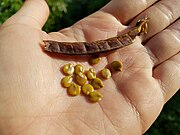| Senna hebecarpa | |
|---|---|

| |
| Scientific classification | |
| Kingdom: | Plantae |
| Clade: | Tracheophytes |
| Clade: | Angiosperms |
| Clade: | Eudicots |
| Clade: | Rosids |
| Order: | Fabales |
| Family: | Fabaceae |
| Subfamily: | Caesalpinioideae |
| Genus: | Senna |
| Species: | S. hebecarpa
|
| Binomial name | |
| Senna hebecarpa | |
| Synonyms | |
|
Cassia hebecarpa Fernald | |
Senna hebecarpa, with the common names American senna[4] and wild senna, is a species of legume native to eastern North America.[3][2][5] [6]
Description[edit]
Senna hebecarpa grows as a sparsely branched perennial plant. It has alternate, compound leaves.[7]
Clusters of light yellow to orange flowers bloom from July to August in North America.[7]
Distribution and habitat[edit]
The plant is found from the Great Lakes region and Maine southwards through the Eastern United States, in the Appalachian Mountains and Atlantic Plains, to Georgia.[3][8]
It is found in moist open woodlands, and in disturbed areas.[8]
Ecology[edit]
It is a larval host and nectar source for the Cloudless Giant Sulphur (Phoebis sennae) butterfly.[7] It is also of special value to native bumble bees.[7] [9]
Conservation status in the United States[edit]
It is endangered in Massachusetts and New Hampshire, threatened in Vermont, as historical in Rhode Island,[10] and as threatened in Connecticut.[11]
Uses[edit]
Senna hebecarpa is cultivated as an ornamental plant, for use as a perennial wildflower and flowering shrub in traditional and wildlife gardens, in natural landscaping projects, and for habitat restoration projects.[7][5][6]
Native American ethnobotany[edit]
The Cherokee use an infusion of the plant for various purposes, including taking it for cramps, heart trouble, giving it to children and adults as a purgative and for fever, and taking it for 'blacks' (hands and eye sockets turn black). They also give an infusion of the root specifically to children for fever. They use a poultice the root for sores, and they use a compound infusion for fainting spells. They also use a compound for pneumonia.[12] The Iroquois use the plant as a worm remedy and take a compound decoction as a laxative.[13]
References[edit]
- ^ NatureServe (1 September 2023). "Senna hebecarpa". NatureServe Network Biodiversity Location Data accessed through NatureServe Explorer. Arlington, Virginia: NatureServe. Retrieved 19 September 2023.
- ^ a b ITIS Standard Report Page: Senna hebecarpa
- ^ a b c United States Department of Agriculture (USDA) (2014): Senna hebecarpa. Retrieved 8-24-2014.
- ^ USDA, NRCS (n.d.). "Senna hebecarpa". The PLANTS Database (plants.usda.gov). Greensboro, North Carolina: National Plant Data Team. Retrieved 10 November 2015.
- ^ a b Blanchan, N. (1916): Wild Flowers: An Aid to Knowledge of our Wild Flowers and their Insect Visitors. TXT fulltext at Project Gutenberg
- ^ a b Blanchan, N. (1917): Wild Flowers Worth Knowing. HTML or TXT fulltext at Project Gutenberg
- ^ a b c d e "Lady Bird Johnson Wildflower Center - The University of Texas at Austin". www.wildflower.org.
- ^ a b "Senna hebecarpa". Germplasm Resources Information Network. Agricultural Research Service, United States Department of Agriculture. Retrieved 16 January 2018.
- ^ The Xerces Society for Invertebrate Conservation: Pollinator Conservation Program
- ^ "Plants Profile for Senna hebecarpa (American senna)". plants.usda.gov. Retrieved 24 December 2017.
- ^ "Connecticut's Endangered, Threatened and Special Concern Species 2015". State of Connecticut Department of Energy and Environmental Protection Bureau of Natural Resources. Retrieved 1 January 2018. (Note: This list is newer and updated from the one used by plants.usda.gov)
- ^ Hamel, Paul B. and Mary U. Chiltoskey, 1975, Cherokee Plants and Their Uses -- A 400 Year History, Sylva, N.C. Herald Publishing Co., page 54
- ^ Herrick, James William, 1977, Iroquois Medical Botany, State University of New York, Albany, PhD Thesis, page 362

